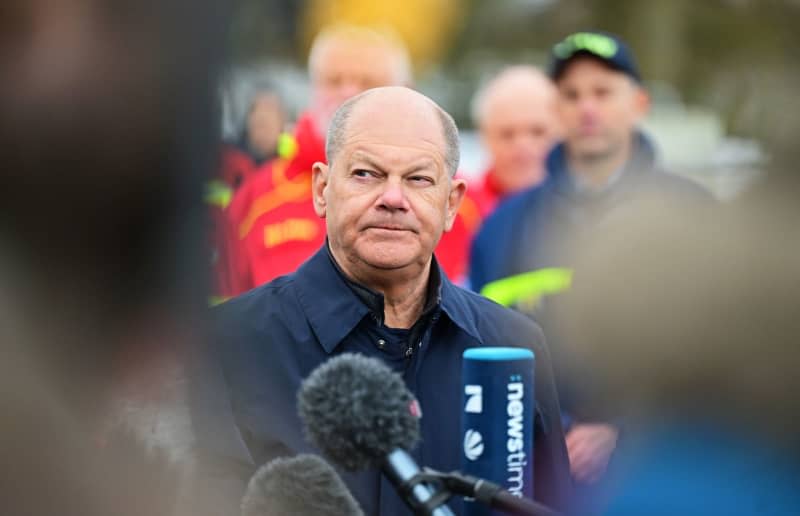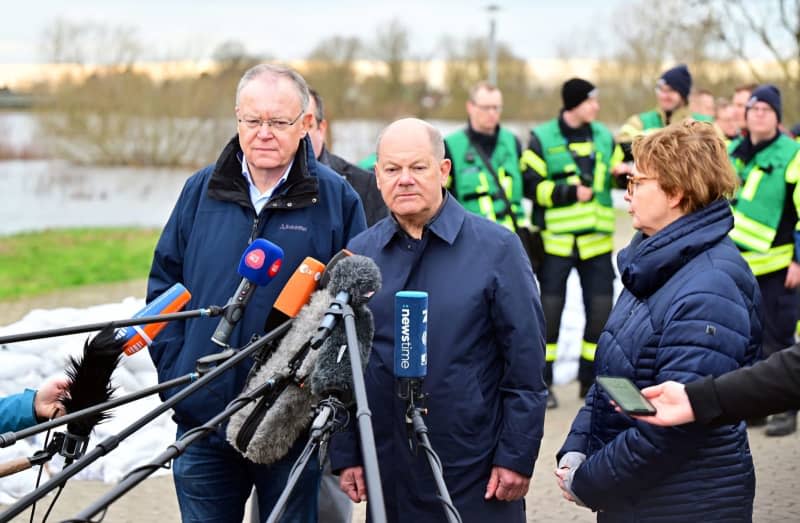Chancellor Scholz visits flood-hit areas in northern Germany

- Oops!Something went wrong.Please try again later.
- Oops!Something went wrong.Please try again later.
German Chancellor Olaf Scholz was visiting the flood-hit areas in the country's northern state of Lower Saxony on Sunday after storms caused disaster in several states.
Scholz travelled to the town of Verden, some 90 kilometres north-west of the state capital Hanover, in the morning, accompanied by Lower Saxon Premier Stephan Weil and state Interior Minister Daniela Behrens.
Scholz took a flyover of the particularly affected areas in northern Lower Saxony. His group was then to be briefed on the situation in Verden on the Aller river.
Scholz then paid tribute to members of the emergency services in Verden, who are likely to spend New Year's Eve fighting against the water.
"The weather and nature are challenging us," he said. "That's why it's important that we stick together in the state. This is also being done everywhere by the responsible organizations, the police, the fire brigade, the technical relief organization, and the German Armed Forces have also provided their support."
Many volunteers are also doing everything they can to minimize the consequences and protect people and homes, he added.
"I can see that the willingness goes far beyond those who are now working professionally or volunteering in aid organizations. Local citizens are also helping out and asking what they can do," said Scholz.
"That is important. I believe that this shows that solidarity exists in our country and that there is a willingness to stick together."
He promised the federal government would do everything possible to help the affected states and municipalities.
He was also expected to speak with those affected by the flooding.
For days, thousands of members of the emergency services have been battling the fallout from heavy rainfall in several parts of Germany. Areas in the states of Lower Saxony, southern Saxony-Anhalt on the border with Thuringia and North Rhine Westphalia were particularly affected by flooding.
The situation in Lower Saxony remains tense, said Premier Weil. "We can see that the pressure of the water masses is still enormous in the northern parts of Lower Saxony," he said in Verden. He welcomed the fact that safety systems have held up so far. "But we know very well that the longer the pressure of the water remains on the dykes, the greater the risk that these dykes could still break."
So far, the country has got off lightly, said Weil. He knew of no fatalities and only one injury to firefighters. He also welcomed the fact that relatively few people have had to be evacuated. "I feel sorry for every single one of them. But measured against the risk that we have already seen in the last few days, a number of well under 2,000 evacuated people, many of whom are now back home, is manageable."
He also praised the community effort, noting there are far more than 100,000 active volunteers across the country and around 6 million to 10 million sandbags have already been filled and placed.
Asked about possible compensation for regions affected, Weil said that currently the focus is on the acute crisis. "After that, we will certainly deal with the other questions of what damage has been caused and what possibilities there are for assistance."
After the rainfall had recently eased slightly, meteorologists are expecting more rain over the next few days, leading to fears that river levels could rise again.
The authorities are particularly concerned about softened dykes.
Interior Minister Nancy Faeser also plans to visit the flood-stricken area on Monday.
Faeser is to meet Interior Minister Behrens on Monday afternoon in the Oldenburg area with emergency services from the Federal Agency for Technical Relief (THW) and the police.
Leaders in the past have also travelled to stricken areas. In 2021, for example, then-chancellor Angela Merkel went to the Ahr Valley in western Germany, which was devastated by flash flooding. She offered support to those affected by the deadly waters in the states of Rhineland-Palatinate and North Rhine Westphalia.


